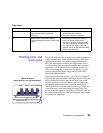59
Defining color
is additive color, and light reflected from ink or toner on a
page is subtractive color.
Additive colors
The colors displayed on computer screens are combina-
tions of red, green, and blue (RGB). Additive color is pro-
duced when selected hues in the color spectrum of white
light are combined (or added) to change how colors are
emphasized. Combinations of red, green, and blue are
additive colors.
• Because red, green, and blue are the foundation for
building all other additive colors, they are called
primary additive colors.
• White is a combination of each of the primary col-
ors. You can see an example of this in a beam of
pure white light striking a prism, separating into a
rainbow of color.
Subtractive colors
Printers use the colors cyan, magenta, and yellow (CMY).
Subtractive color is produced when white light strikes a
pigment that absorbs (or subtracts) most of the hues and
reflects only one (or a few) back to the eye. In addition to
human-made subtractive pigments (such as ink or toner
on paper, or dye in fabric), most natural pigments are sub-
tractive.
• Combinations of cyan, magenta, and yellow are
subtractive colors.
• Because cyan, magenta, and yellow are the founda-
tion for building all other subtractive colors, they
are called primary subtractive colors.
• Black is produced by overlaying a mixture of each
of the subtractive primary colors. Black produced
this way is not a pure black; it is called process
black, or composite black. (Your printer can print
with pure black by using the black toner.)


















